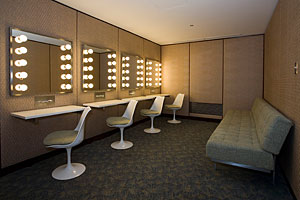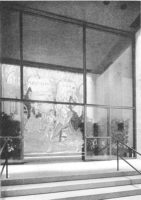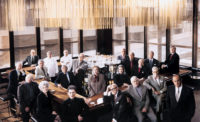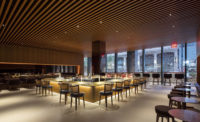New York City’s legendary Four Seasons restaurant, now celebrating its 50th anniversary, has embarked on the restoration of its famed Philip Johnson-designed interior in the Seagram Building, completed in 1958.
Phyllis Lambert, the architect and patron who convinced her father, Samuel Bronfman, owner of the Seagram Company, to choose Ludwig Mies van der Rohe and Johnson as the architects of his new headquarters building on Park Avenue, guided the selection of Belmont Freeman, FAIA, as the new architect for the restoration of this culinary outpost. Lambert, whose family still retains majority ownership of the restaurant, along with minority stakeholders and restaurateurs Julian Niccolini and Alex von Bidder, felt Freeman would be sympathetic to refurbishing the Four Season’s interiors, which received New York City landmark status in 1989: Freeman’s New York-based office is particularly known for its crafted restorations and modernist renovations of campus structures, retail facilities, and residences.

Photo © Jennifer Calais Smith
New York City’s legendary Four Seasons Restaurant, now celebrating its 50th anniversary, has embarked on the restoration of its Philip Johnson-designed interior. Improvements will occur gradually. A ladies’ room (above) is one of the first items on the list.
“It is hard to say how long this will take,” says Freeman, about the piecemeal process of spiffing up the Four Seasons that began in July. In order to keep the restaurant open, improvements will occur gradually as “surgical interventions,” he says. The first item on the list was the ladies’ room off the 52nd Street lobby. Next Freeman will turn to heavily trafficked passageways and stairs.
Certain surprises have already presented themselves: for example Freeman discovered that the stair railings to the various levels in the restaurant, which were painted brown in the 1970s, are actually a combination of stainless steel vertical spindles and bronze frames. “Mixing metals was very Philip,” Freeman notes.
The ladies’ room walls had been sheathed in synthetic suede in recent years. Although Freeman had only a black and white photo to go by, Lambert recalled the original wallcovering might have been from Fortuny. The company was able to verify that it was the same pink, gold, and silver fabric that Johnson also used on the bedroom walls of his brick guest house (1949) at his Glass House in New Canaan, Connecticut. So once again a Fortuny fabric covers the walls where ladies primp while sitting in Saarinen pedestal chairs at individual vanities.
A very noticeable improvement is the replacement of the notoriously harsh strips of naked incandescent globes around the vanities with a cold cathode lamp on dimmers for a soft, but not hot, light. “We want to make the lighting more energy efficient throughout the restaurant, and with better photometrics,” Freeman says, referring to the focus of the light beam and its perceived brightness. The architect is working with original manufacturers of the fixtures, Edison Price Lighting, and with lighting consultant WALD Studio on this task.
Generally the much-admired wood—French black walnut in the restaurant, Brazilian rosewood in parts of the ladies’ room—is still in good condition and needs only cleaning. When the recently installed blue-gray carpet in the restaurant is ready to be replaced, Freeman hopes to return it to the red and black colors Johnson had formerly designed.
The main dilemma in the restoration concerns the famous swagged chains that designer Marie Nichols had created for the restaurant’s windows walls. The original manufacturers of the metal curtains, which came in gold, copper, and silver anodized aluminum, is out of business and no source has been found yet to replace them. “If need be, we’ll have to reassemble broken chains and make links,” says Freeman.
Owing to the subtlety of the restoration process, few should notice these improvements. Yet as Freeman notes, the restaurant has been “blandified” over the years, and he wants to change that. “We’re going to glam it up just a bit by going back to Johnson’s original color and material choices.”






